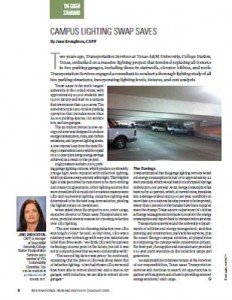Two years ago, Transportation Services at Texas A&M University, College Station, Texas, embarked on a massive lighting project that involved replacing all fixtures in five parking garages, including those in stairwells, elevator lobbies, and roofs. Transportation Services engaged a consultant to conduct a thorough lighting study of all five parking structures, incorporating lighting levels, fixtures, and cost analysis.
Texas A&M is the sixth-largest university in the United States, with approximately 50,000 students and 12,000 faculty and staff on a campus that covers more than 5,500 acres. The university runs a $20 million parking operation that includes more than 36,000 parking spaces, 120 surface lots, and five garages.
The $2 million retrofit to low-energy fixtures was designed to reduce energy consumption, costs, and carbon emissions, and improve lighting levels. A low-interest loan from the State Energy Conservation Office will be repaid on a 10-year plan using energy savings achieved as a result of the project.
High pressure sodium (HPS) parking garage lighting fixtures, which produce a yellowish/orange light, were replaced with induction lighting, which produces a very efficient white light. This brighter light is also perceived by customers to be more inviting and cleaner in appearance. Other lighting sources that were considered but ruled out for various reasons were LED and fluorescent lighting. Induction lighting was determined to be the best long-term solution, yielding the highest return on investment.
When asked about the project in 2011, Peter Lange, executive director of Texas A&M Transportation Services, provided several reasons for choosing induction over LED lighting.
“The first reason for choosing induction over LED was length of life,” he said. At that time, LED was a relatively new technology with very few installations older than three years. “We think LED will be a proven technology at some point in the future, but felt it was not at a maturity level that we were comfortable with.”
“The second big factor was price,” he continued, explaining that the price of LED was about twice that of induction lighting. “If we had chosen LED, we would have been able to retrofit about two-and-a-half of our garages. With induction, we are able to retrofit all five garages.”
The Savings
It was anticipated that the garage lighting retrofits would cut energy consumption in half, or to approximately 2.2 kWh annually, which would result in anticipated savings of about $175,000 per year. So far, energy consumption has been cut by 40 percent, which, at current rates, translates into a savings of about $230,000 per year. Reliability on more than 2,700 fixtures has also proven to be improved; fewer than 1 percent of the ballasts have been replaced since the change. Texas A&M’s Department of Utilities & Energy Management continues to monitor the energy consumption and report back to transportation services.
Transportation services and the university’s departments of utilities and energy management, facilities planning and construction, and facilities services, plus the Smart Energy Campus Initiative, all played roles in completing the campus-wide conservation project. For their part, the supplier and manufacturer provided a 10-year parts warranty on the induction lamps and generators.
“As sustainability initiatives remain at the forefront of our responsibilities, Texas A&M Transportation Services will continue to search for opportunities to partner with suppliers and others in providing efficient energy solutions,” said Lange.
June Broughton, CAPP, is manager of Texas A&M University College Station Transportation Services and a member of IPI’s Sustainability Committee. She can be reached at june@tamu.edu or 979.862.7371.
TPP-2013-08-Campus Lighting Swap Saves

